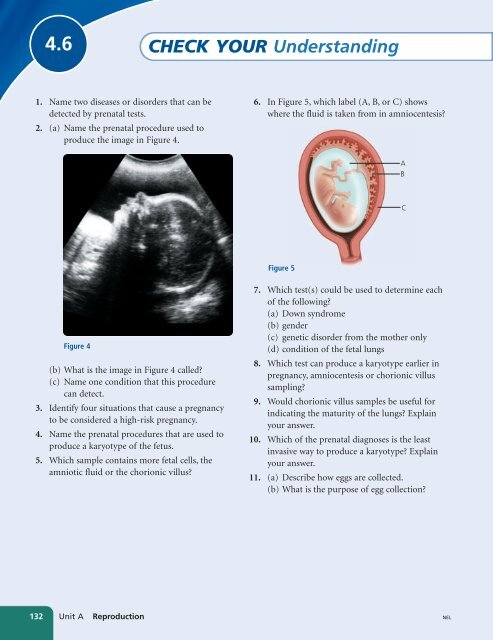Unit A Reproduction
Unit A Reproduction
Unit A Reproduction
You also want an ePaper? Increase the reach of your titles
YUMPU automatically turns print PDFs into web optimized ePapers that Google loves.
4.6<br />
CHECK YOUR Understanding<br />
1. Name two diseases or disorders that can be<br />
detected by prenatal tests.<br />
2. (a) Name the prenatal procedure used to<br />
produce the image in Figure 4.<br />
6. In Figure 5, which label (A, B, or C) shows<br />
where the fluid is taken from in amniocentesis?<br />
A<br />
B<br />
C<br />
Figure 5<br />
Figure 4<br />
(b) What is the image in Figure 4 called?<br />
(c) Name one condition that this procedure<br />
can detect.<br />
3. Identify four situations that cause a pregnancy<br />
to be considered a high-risk pregnancy.<br />
4. Name the prenatal procedures that are used to<br />
produce a karyotype of the fetus.<br />
5. Which sample contains more fetal cells, the<br />
amniotic fluid or the chorionic villus?<br />
7. Which test(s) could be used to determine each<br />
of the following?<br />
(a) Down syndrome<br />
(b) gender<br />
(c) genetic disorder from the mother only<br />
(d) condition of the fetal lungs<br />
8. Which test can produce a karyotype earlier in<br />
pregnancy, amniocentesis or chorionic villus<br />
sampling?<br />
9. Would chorionic villus samples be useful for<br />
indicating the maturity of the lungs? Explain<br />
your answer.<br />
10. Which of the prenatal diagnoses is the least<br />
invasive way to produce a karyotype? Explain<br />
your answer.<br />
11. (a) Describe how eggs are collected.<br />
(b) What is the purpose of egg collection?<br />
132 <strong>Unit</strong> A <strong>Reproduction</strong><br />
NEL

















